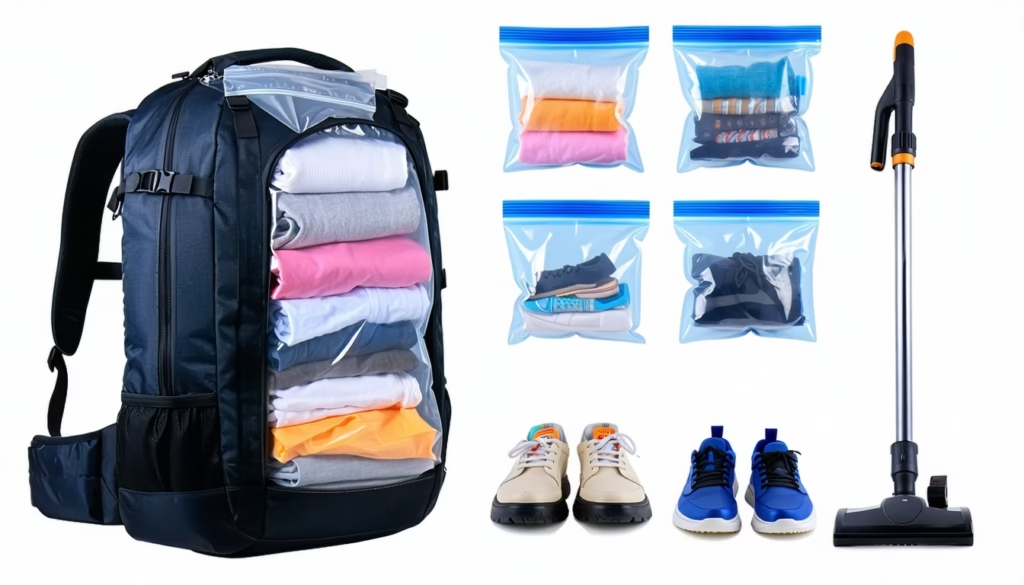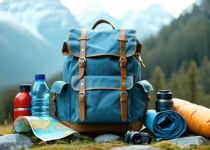How To Use Vacuum Bags For Efficient Space-Saving Packing

Are you tired of wrestling with an overstuffed backpack every time you travel? Picture this: you’ve got your hiking boots, bulky sweater, and all your essentials lined up, but when it’s time to pack, there’s just no room left. In this guide, you’ll learn how to use vacuum bags for efficient space-saving packing so you can fit more gear without bulging seams.
Here’s the thing, vacuum-sealed storage isn’t just for mothballing holiday linens. By squeezing out air, these clever bags can shrink bulky items like jackets and sweaters down to a fraction of their original size. Let’s walk through this step by step and unlock extra backpack space—your next adventure awaits.
1. Choose the Right Vacuum Bag
Not all vacuum bags are created equal. Picking the best option up front makes every later step smoother and keeps your gear protected.
Types of Vacuum Bags
| Bag Type | Pros | Cons |
|---|---|---|
| Manual Vacuum Bag | No pump required, lightweight | Requires elbow grease, slower seal |
| Electric Vacuum Bag | Fast, consistent seal | Bulky pump, needs power source |
| Travel-Specific Bags | Compact designs, built-in pump adapters | Smaller capacity |
What to Look For
- Material durability: thicker plastic resists punctures when you stuff it into rough terrain
- Seal strength: double-zip closures help prevent air leaks
- Size options: get variety packs (small, medium, large) so you can match bag size to item bulk
- Pump type: manual pumps are handy off-grid, electric pumps work faster if you’ve got power
For a quick rundown on top picks, check out our roundup of best vacuum-sealed bags for packing bulky clothes.
2. Prepare Items for Packing
Before you start pressing air out, sort and prep your gear. A little planning up front means you’ll seal faster and pack smarter.
Sort by Category
- Bulky clothing: winter coats, hoodies, fleece jackets
- Soft gear: towels, socks, undies (they compress nicely)
- Fragile items: electronics, chargers (keep these out of vacuum bags)
Clean and Dry
Mold growth is the last thing you want in your backpack. Make sure everything you plan to vacuum-seal is:
- Completely dry—wipe off moisture from damp socks or wet layers
- Free of loose dirt—give that hiking sweater a quick shake outdoors
Fold vs. Roll?
You might be wondering, is it better to roll or fold before sealing? Rolling helps prevent sharp creases, but neat folds pack more efficiently when you extract air. For a deep dive, see our guide on how to roll vs fold clothes for maximum suitcase space.
3. Fill and Seal Bags Properly
Now for the satisfying part—watching air vanish as your bag shrinks.
Filling Steps
- Lay the bag flat on a clean surface
- Insert items without overstuffing—leave about 2–3 inches of space at the top
- Close the zip seal slowly, pressing firmly along the length to lock
Pro Tips
- Don’t cram too much in one bag—it can stress the seams
- Use a lint roller on fuzzy fabrics first to avoid gunk on the seal
- Label each bag with a pen so you know what’s inside without unsealing
4. Remove Air Efficiently
Getting every last bit of air out is key to maximum space-saving. Whether you’re using a manual or electric pump, follow these tips.
Manual Pump Technique
- Place the valve cap over the pump nozzle securely
- Pump in short, steady strokes until resistance increases
- Twist the valve closed immediately to keep the vacuum
Electric Pump Shortcut
- Attach pump adapter, then hold the power button until the bag feels rigid
- Be mindful not to overdo it—sharp items inside can puncture from too much suction
Still debating vacuum bags versus classic compression sacks? See our comparison in how to use compression bags to double suitcase space.
5. Arrange Bags in Your Backpack
With your vacuum-sealed pouches at the ready, it’s time to pack them into your backpack like a pro.
Layer Strategically
- Bottom layer: heavy, low-flex items like your compact sleeping bag
- Middle layer: vacuum bags packed with bulky clothing
- Top layer: daily-access items—rain jacket, snacks, electronics
Use Every Nook
- Slide small, flattened vacuum bags into side pockets for water bottles or gadgets
- Tuck narrow ones between frame rails or compression straps
Want more tricks for maximizing your pack? Don’t miss these genius packing tricks for fitting everything in a backpack.
6. Maintain Vacuum Bag Care
Vacuum bags are handy, but they’re an investment you’ll want to protect. A few simple habits extend their lifespan.
- Avoid sharp edges—zipper pulls, tent stakes, and buckles can nick the plastic
- Clean seals after each use—wipe with a damp cloth to remove dust
- Store flat when not in use to prevent permanent creasing
For extra organization inside your pack, layer vacuum bags with packing cubes or zip pouches.
Frequently Asked Questions
How many uses can I get from one vacuum bag?
Most quality bags last 50+ trips if cared for properly. Watch out for tiny tears—patch kits can buy extra mileage.
Can vacuum bags damage delicate fabrics?
Delicate knits can stretch under strong suction. For fragile items, try gentler compression or use a lower vacuum setting.
Will vacuum bags save me from airline baggage fees?
They can shrink up to 80% volume, but weight stays the same. You won’t slip under weight limits, but you’ll avoid bulky fees on oversized suitcases.
What if my pump fails on the trail?
Keep a small manual hand pump as a backup. Or twist-and-fold the open end of your bag, then seal quickly to trap air naturally.
Can I reuse vacuum bags for non-clothing items?
Yes—camping pillows, inflatable mattresses, and even compact tents benefit from the same space-saving trick. See our space-saving hacks for camping backpacks and gear.
How do I get the air out without a pump?
You can press out air manually—flatten the bag on a flat surface, then fold it toward the seal like a taco. It takes a bit more elbow grease, but it works in a pinch.
Do vacuum bags eliminate odors?
They lock out fresh air, which prevents mustiness, but trapped smells stay inside. Launder clothes before sealing and consider an odor-absorbing sachet if needed.
Final Packing Recommendations
Vacuum bags can be a total game-changer when you want to save precious backpack space. By choosing durable bags, prepping your gear properly, and mastering airtight seals, you’ll double or triple your free packing room.
Next time you gear up, give these steps a try and see the difference—no more zippered panic or toss-and-cram madness. If you’ve discovered a vacuum bag hack we didn’t cover, share it in the comments below so fellow travelers can benefit too.


